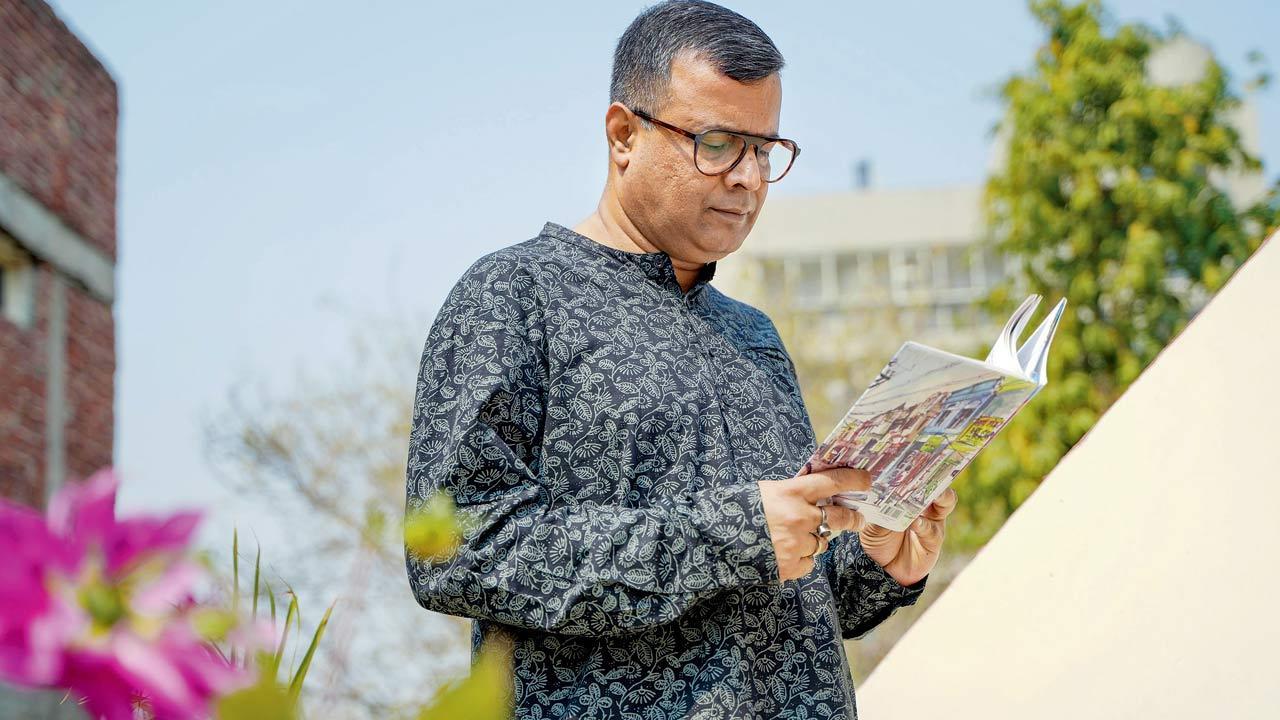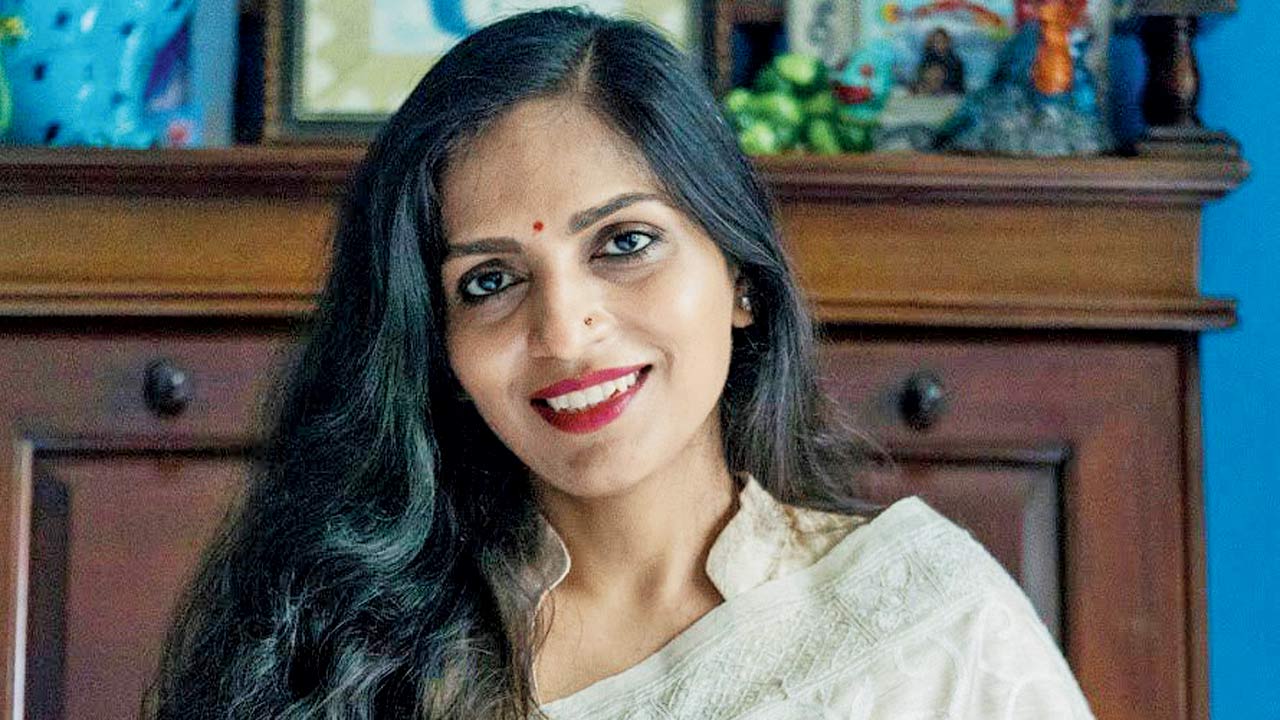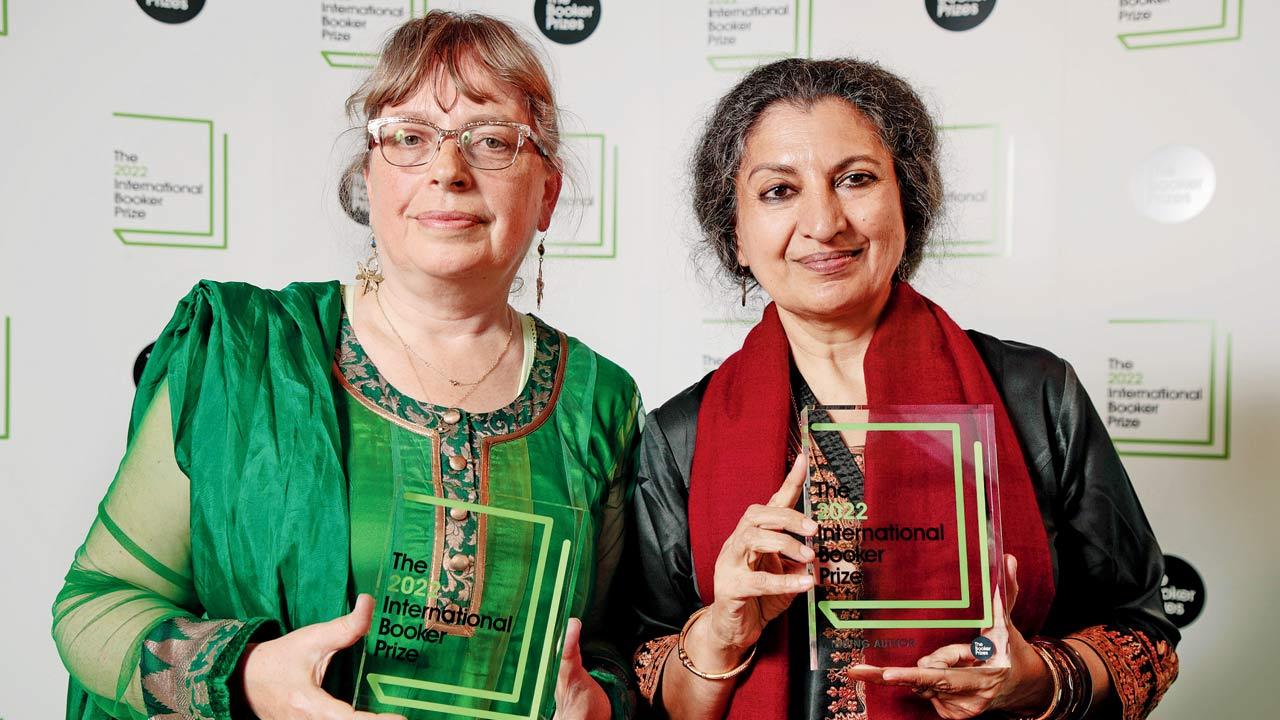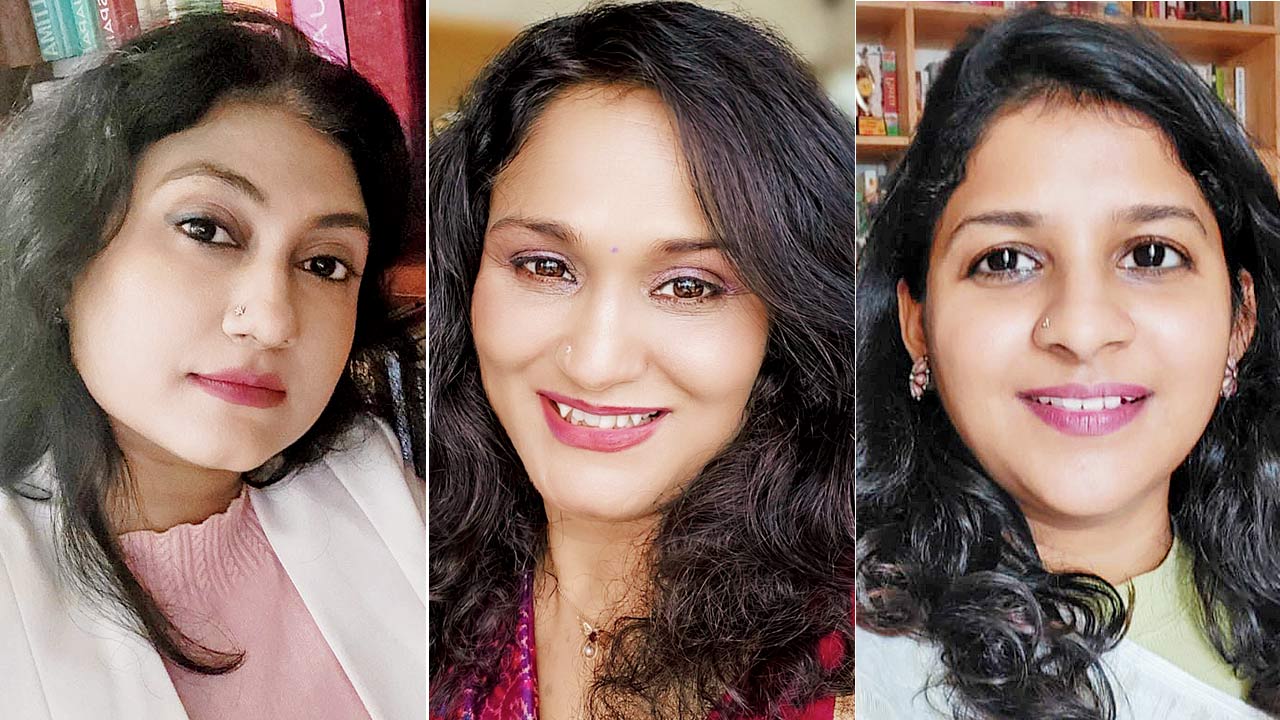International recognition for Vinod Kumar Shukla and Geentajali Shree is proof that Hindi writing is finally finding pride of place on the global map. But with publishers at the New Delhi World Book Fair disappointed with overall sales, what exactly does Hindi literature need?

Delhi-based Hindi novelist and professor Prabhat Ranjan, describes Hindi as “the language of small town people... Jo gaon, kasbo [tiny settlements] aur chhote shehero mein rehte hain, aur rickshaw chalate hain”. “Most of the writers [of Hindi] also belong to the same strata of society,” he says. Pic/Nishad Alam
At 86, Hindi author Vinod Kumar Shukla is older than new India. The experience of having lived through innumerable political and social upheavals is visible in his stories, making his work a celebration and expression of what it means to be an Indian from the Hindi belt. And yet, fame has mostly eluded the Sahitya Akademi Award-winning writer behind the masterpieces, Naukar ki Kameez and Deewar Mein Ek Khirkee Rahati Thi.
Last week, Raipur-based Shukla was awarded the PEN/Nabokov Award for Achievement in International Literature, bringing much deserved attention to his writings in Hindi, a language that has continued to draw a lot of political attention—with recent demands to make it the national language of the country—but which continues to be ignored in the literary sphere.
![At 86, Hindi author Vinod Kumar Shukla is older than new India. The experience of having lived through innumerable political and social upheavals is visible in his stories, making his work a celebration and expression of what it means to be an Indian from the Hindi belt. And yet, fame has mostly eluded the Sahitya Akademi Award-winning writer behind the masterpieces, Naukar ki Kameez and Deewar Mein Ek Khirkee Rahati Thi. Last week, Raipur-based Shukla was awarded the PEN/Nabokov Award for Achievement in International Literature, bringing much deserved attention to his writings in Hindi, a language that has continued to draw a lot of political attention—with recent demands to make it the national language of the country—but which continues to be ignored in the literary sphere. While Bollywood has appropriated the language seamlessly, and found it a global “massy audience”, reading Hindi is still not a universal Indian experience. Partner at leading publishing house Rajpal and Sons, Meera Johri explains this this: “Reading is linked to two factors—the literacy levels [in the region] and the purchasing power of the people living there.” The Hindi heartland, which encompasses parts of northern, central, eastern and western India, including Bihar, Chhattisgarh, Haryana, Jharkhand, Madhya Pradesh, Rajasthan, Uttar Pradesh, Himachal Pradesh and Uttarakhand, doesn’t have “positive literacy levels”. “Neither do its people have enough discretionary income to buy books.” Also, “Hindi is a more spoken and listened to language,” says Johri. “We all love to listen to Hindi songs and watch Hindi movies, but strangely the script is not as widely read. I remember in school I stopped studying Hindi by Class VIII. If you do not belong to the world of Hindi, you can very well get along in life without reading a word of it ever again,” she says. This explains why the readership has remained low for long. “But that doesn’t mean that Hindi writers have stopped writing,” says Delhi-based novelist Prabhat Ranjan, who originally hails from Sitamarhi in Bihar. He—and this might seem like a snub to the ‘elite’ Hindi-speaking Delhite—describes Hindi as “the language of small town people... Jo gaon, kasbo [tiny settlements] aur chhote shehero mein rehte hain, aur rickshaw chalate hain”. “Most of the writers [of Hindi] also belong to the same strata of society.” Their concerns are rooted in the concerns of the people that they are surrounded by, and that makes their stories one of a kind, he thinks. Ranjan, a professor of Hindi at Delhi University, began writing Hindi novels 20 years ago. “Although I got recognition for my work only in 2015, when I wrote a book about the courtesan culture of Bihar [Kothagoi],” he explains. The global attention that authors like Shukla and Geetanjali Shree, who last year won the International Booker Prize for Tomb of Sand (translated by Daisy Rockwell) are receiving, and the digital boom that has lead to a spurt in ebooks, audio books and podcasts, might prove to be a game-changer for Hindi literature. Jaipur-based Hindi novelist Manisha Kulshreshtha has been writing for the last 35 years. Now six novels old, Kulshreshtha remembers how challenging it was to get her earlier works published. “At the time, it was assumed that all the great Hindi writers hail from Delhi,” she says, adding that this unspoken bias and “groupism” discounted Hindi writers like herself. “Once my first novel got published [Kathputliyan, 2008], publishers started taking my writing more seriously.” Kulshreshtha who is married to an Indian Air Force officer, whose postings were in remote parts of the country, says another challenge was access to good Hindi reading material. “I was an avid reader, but there were hardly any local bookstores that sold Hindi books. There was a massive gap, between the publisher, seller and reader.” According to Minakshi Thakur, publisher, Indian Literature division at Westland Books, distribution has always been the biggest drawback of Hindi publishing. “The bigwigs of Hindi publishing never bothered to make an effort,” she says. “Their [publishers] revenue has been heavily dependent on government subsidies—their books would mostly go into public libraries and government departments that had an annual budget to buy publications.” It wasn’t a very transparent business either, she says. “There were no proper contracts signed. Royalty statements wouldn’t go out on time either.” Prabhat Ranjan agrees that even today, many publishers don’t hand an advance to their Hindi writers. “Most Hindi writers don’t know how many books they have sold either.” Back in 1999, Kulshreshtha remembers starting Hindinest.com, a Hindi literary portal that published poetry and short stories by fellow writers. “That took off in a big way. People from America would write to me saying, ‘Aisa laga ki humme ghar ka khana mila’,” she recalls. Retail giants like Amazon, which also allowed writers to self-publish, made writing in Hindi more democratic, she feels. The genius of Vinod Kumar Shukla is in his writing, says Mumbai-based bilingual author Anukrti Upadhyay, who is out with a new short story collection The Blue Women. “The way he writes is spare, devoid of ornamentation... his stories are enigmatic, allegorical and wander into surrealism or what many understand as ‘magical realism’. There is no divide between the ordinary and not-so-ordinary.” It’s what drew Upadhyay to Shukla’s work. But, for most part, Upadhyay feels there was this dearth of experimentation in plot and form by writers of Hindi literature. “When I started reading contemporary Hindi literature, I was a bit disappointed. I felt that we were stuck in a set of homogeneous experiences and expressions. Writers were not pushing the boundaries enough... the craft seemed like it was stagnating,” says Upadhyay. Her Hindi short story collection, Japani Sarai, and novella Neena Aunty, were a direct response to this. Johri of Rajpal and Sons is hopeful. “Hindi is becoming cool again,” she says, “The recognition [for Shukla and Shree’s works] has put Hindi on the world map and has evoked interest among other publishers to look at Hindi as a potential for possible translations. Many young writers are writing in Hindi. I even think publishers are investing more time and resources to make Hindi literature accessible to all.” The winds of change are already blowing, feels Aditi Maheshwari, executive director of Vani Prakashan. She says the Hindi which we use in our literature today is barely 100 years old. “It’s very different from the Hindi that was spoken and written in the 19th century, and what we therefore see today, is a fairly young language that has grown with an independent country, and which is capturing the scenarios and life experiences of a society that is new to its own conditions and problems. Because it’s so rooted and basic, it’s now connecting with a global audience.” Due to this increased interest, Vani Prakashan has increased its authors’ signing amounts by 20 per cent, says Maheshwari. Only recently the publishing house also released Kinshuk Gupta’s Ye Dil Hai Ki Chor Darwaja at the New Delhi World Book Fair, which is a short story collection that draws on the LGBTQiA+ experience. Vani Prakashan already has over 200-plus audio books and more than 5,000 ebooks in its collection. The constant churning of work, however, is yet to result in sales. At the just concluded nine-day New Delhi World Book Fair held at the redeveloped convention centre at Pragati Maidan, the overall sales of Hindi books was underwhelming, says Maheshwari. Reports put it down to exam season keeping students away, poor positioning of stalls and low internet connectivity that stalled online transactions. But she feels that working across formats, will give Hindi publishers an edge in the future. Westland Books in association with Pratilipi, one of India’s largest storytelling platform, this month announced launching its paperback imprint for mass market books in Indian languages. Some of its top-performing novels from the app, which includes two novels Hindi by crime fiction and web series writer Amit Khan (Night Club and Qaidi) and Anil Shekhar Amas’ Tantric Aghoranand series, will be published under the new imprint. “The writers come from varied backgrounds... we have housewives, government officials, former tantrics,” says Thakur of Westland. “We have data on the themes, plots or characters that work in various language territories; each state in India reads differently. The average active user of the app is spending 60 to 80 minutes daily on it. Some of these long-format stories have been read lakhs of times [Tantric Aghoranand series, comprising 40 episodes, was read 1.20 lakh times]; many of the top-performing stories have been translated into other languages and adapted across formats like audio, podcast and comic and pitched as stories to be developed for movies and web series. These are exciting times for publishing, especially in Hindi—a story can originate in any format and morph into another and yet another, but [more importantly] a story can also originate from any home, any village, any town in India.”](https://images.mid-day.com/images/images/2023/mar/We-have-the-b_e.jpg) At 86, Hindi author Vinod Kumar Shukla is older than new India. The experience of having lived through innumerable political and social upheavals is visible in his stories, making his work a celebration and expression of what it means to be an Indian from the Hindi belt. And yet, fame has mostly eluded the Sahitya Akademi Award-winning writer behind the masterpieces, Naukar ki Kameez and Deewar Mein Ek Khirkee Rahati Thi.
At 86, Hindi author Vinod Kumar Shukla is older than new India. The experience of having lived through innumerable political and social upheavals is visible in his stories, making his work a celebration and expression of what it means to be an Indian from the Hindi belt. And yet, fame has mostly eluded the Sahitya Akademi Award-winning writer behind the masterpieces, Naukar ki Kameez and Deewar Mein Ek Khirkee Rahati Thi.
While Bollywood has appropriated the language seamlessly, and found it a global “massy audience”, reading Hindi is still not a universal Indian experience. Partner at leading publishing house Rajpal and Sons, Meera Johri explains this this: “Reading is linked to two factors—the literacy levels [in the region] and the purchasing power of the people living there.”
The Hindi heartland, which encompasses parts of northern, central, eastern and western India, including Bihar, Chhattisgarh, Haryana, Jharkhand, Madhya Pradesh, Rajasthan, Uttar Pradesh, Himachal Pradesh and Uttarakhand, doesn’t have “positive literacy levels”. “Neither do its people have enough discretionary income to buy books.”
 Mumbai-based author Anukrti Upadhyay feels there has been a dearth of experimentation in plot and form by writers of Hindi literature. Her Hindi short story collection, Japani Sarai, and novella Neena Aunty, were a direct response to this
Mumbai-based author Anukrti Upadhyay feels there has been a dearth of experimentation in plot and form by writers of Hindi literature. Her Hindi short story collection, Japani Sarai, and novella Neena Aunty, were a direct response to this
Also, “Hindi is a more spoken and listened to language,” says Johri. “We all love to listen to Hindi songs and watch Hindi movies, but strangely the script is not as widely read. I remember in school I stopped studying Hindi by Class VIII. If you do not belong to the world of Hindi, you can very well get along in life without reading a word of it ever again,” she says. This explains why the readership has remained low for long.
“But that doesn’t mean that Hindi writers have stopped writing,” says Delhi-based novelist Prabhat Ranjan, who originally hails from Sitamarhi in Bihar. He—and this might seem like a snub to the ‘elite’ Hindi-speaking Delhite—describes Hindi as “the language of small town people... Jo gaon, kasbo [tiny settlements] aur chhote shehero mein rehte hain, aur rickshaw chalate hain”. “Most of the writers [of Hindi] also belong to the same strata of society.” Their concerns are rooted in the concerns of the people that they are surrounded by, and that makes their stories one of a kind, he thinks. Ranjan, a professor of Hindi at Delhi University, began writing Hindi novels 20 years ago. “Although I got recognition for my work only in 2015, when I wrote a book about the courtesan culture of Bihar [Kothagoi],” he explains.
 Daisy Rockwell and Geetanjali on the red carpet with their winners medals at The 2022 International Booker Prize Winner Ceremony at One Marylebone on May 26, 2022 in London, England. Pic/Getty Images
Daisy Rockwell and Geetanjali on the red carpet with their winners medals at The 2022 International Booker Prize Winner Ceremony at One Marylebone on May 26, 2022 in London, England. Pic/Getty Images
The global attention that authors like Shukla and Geetanjali Shree, who last year won the International Booker Prize for Tomb of Sand (translated by Daisy Rockwell) are receiving, and the digital boom that has lead to a spurt in ebooks, audio books and podcasts, might prove to be a game-changer for
Hindi literature.
Jaipur-based Hindi novelist Manisha Kulshreshtha has been writing for the last 35 years. Now six novels old, Kulshreshtha remembers how challenging it was to get her earlier works published. “At the time, it was assumed that all the great Hindi writers hail from Delhi,” she says, adding that this unspoken bias and “groupism” discounted Hindi writers like herself. “Once my first novel got published [Kathputliyan, 2008], publishers started taking my writing more seriously.”
 Minakshi Thakur, Manisha Kulshreshtha and Aditi Maheshwari
Minakshi Thakur, Manisha Kulshreshtha and Aditi Maheshwari
Kulshreshtha who is married to an Indian Air Force officer, whose postings were in remote parts of the country, says another challenge was access to good Hindi reading material. “I was an avid reader, but there were hardly any local bookstores that sold Hindi books. There was a massive gap, between the publisher, seller and reader.”
According to Minakshi Thakur, publisher, Indian Literature division at Westland Books, distribution has always been the biggest drawback of Hindi publishing. “The bigwigs of Hindi publishing never bothered to make an effort,” she says. “Their [publishers] revenue has been heavily dependent on government subsidies—their books would mostly go into public libraries and government departments that had an annual budget to buy publications.” It wasn’t a very transparent business either, she says. “There were no proper contracts signed. Royalty statements wouldn’t go out on time either.” Prabhat Ranjan agrees that even today, many publishers don’t hand an advance to their Hindi writers. “Most Hindi writers don’t know how many books they have sold either.”
Back in 1999, Kulshreshtha remembers starting Hindinest.com, a Hindi literary portal that published poetry and short stories by fellow writers. “That took off in a big way. People from America would write to me saying, ‘Aisa laga ki humme ghar ka khana mila’,” she recalls. Retail giants like Amazon, which also allowed writers to self-publish, made writing in Hindi more democratic, she feels.
The genius of Vinod Kumar Shukla is in his writing, says Mumbai-based bilingual author Anukrti Upadhyay, who is out with a new short story collection The Blue Women. “The way he writes is spare, devoid of ornamentation... his stories are enigmatic, allegorical and wander into surrealism or what many understand as ‘magical realism’. There is no divide between the ordinary and not-so-ordinary.” It’s what drew Upadhyay to Shukla’s work. But, for most part, Upadhyay feels there was this dearth of experimentation in plot and form by writers of Hindi literature. “When I started reading contemporary Hindi literature, I was a bit disappointed. I felt that we were stuck in a set of homogeneous experiences and expressions. Writers were not pushing the boundaries enough... the craft seemed like it was stagnating,” says Upadhyay. Her Hindi short story collection, Japani Sarai, and novella Neena Aunty, were a direct response to this.
Johri of Rajpal and Sons is hopeful. “Hindi is becoming cool again,” she says, “The recognition [for Shukla and Shree’s works] has put Hindi on the world map and has evoked interest among other publishers to look at Hindi as a potential for possible translations. Many young writers are writing in Hindi. I even think publishers are investing more time and resources to make Hindi literature accessible to all.”
The winds of change are already blowing, feels Aditi Maheshwari, executive director of Vani Prakashan. She says the Hindi which we use in our literature today is barely 100 years old. “It’s very different from the Hindi that was spoken and written in the 19th century, and what we therefore see today, is a fairly young language that has grown with an independent country, and which is capturing the scenarios and life experiences of a society that is new to its own conditions and problems. Because it’s so rooted and basic, it’s now connecting with a global audience.”
Due to this increased interest, Vani Prakashan has increased its authors’ signing amounts by 20 per cent, says Maheshwari. Only recently the publishing house also released Kinshuk Gupta’s Ye Dil Hai Ki Chor Darwaja at the New Delhi World Book Fair, which is a short story collection that draws on the LGBTQiA+ experience. Vani Prakashan already has over 200-plus audio books and more than 5,000 ebooks in its collection.
The constant churning of work, however, is yet to result in sales. At the just concluded nine-day New Delhi World Book Fair held at the redeveloped convention centre at Pragati Maidan, the overall sales of Hindi books was underwhelming, says Maheshwari. Reports put it down to exam season keeping students away, poor positioning of stalls and low internet connectivity that stalled online transactions. But she feels that working across formats, will give Hindi publishers an edge in the future.
Westland Books in association with Pratilipi, one of India’s largest storytelling platform, this month announced launching its paperback imprint for mass market books in Indian languages. Some of its top-performing novels from the app, which includes two novels Hindi by crime fiction and web series writer Amit Khan (Night Club and Qaidi) and Anil Shekhar Amas’ Tantric Aghoranand series, will be published under the new imprint. “The writers come from varied backgrounds... we have housewives, government officials, former tantrics,” says Thakur of Westland. “We have data on the themes, plots or characters that work in various language territories; each state in India reads differently. The average active user of the app is spending 60 to 80 minutes daily on it. Some of these long-format stories have been read lakhs of times [Tantric Aghoranand series, comprising 40 episodes, was read 1.20 lakh times]; many of the top-performing stories have been translated into other languages and adapted across formats like audio, podcast and comic and pitched as stories to be developed for movies and web series. These are exciting times for publishing, especially in Hindi—a story can originate in any format and morph into another and yet another, but [more importantly] a story can also originate from any home, any village, any town in India.”
 Subscribe today by clicking the link and stay updated with the latest news!" Click here!
Subscribe today by clicking the link and stay updated with the latest news!" Click here!










